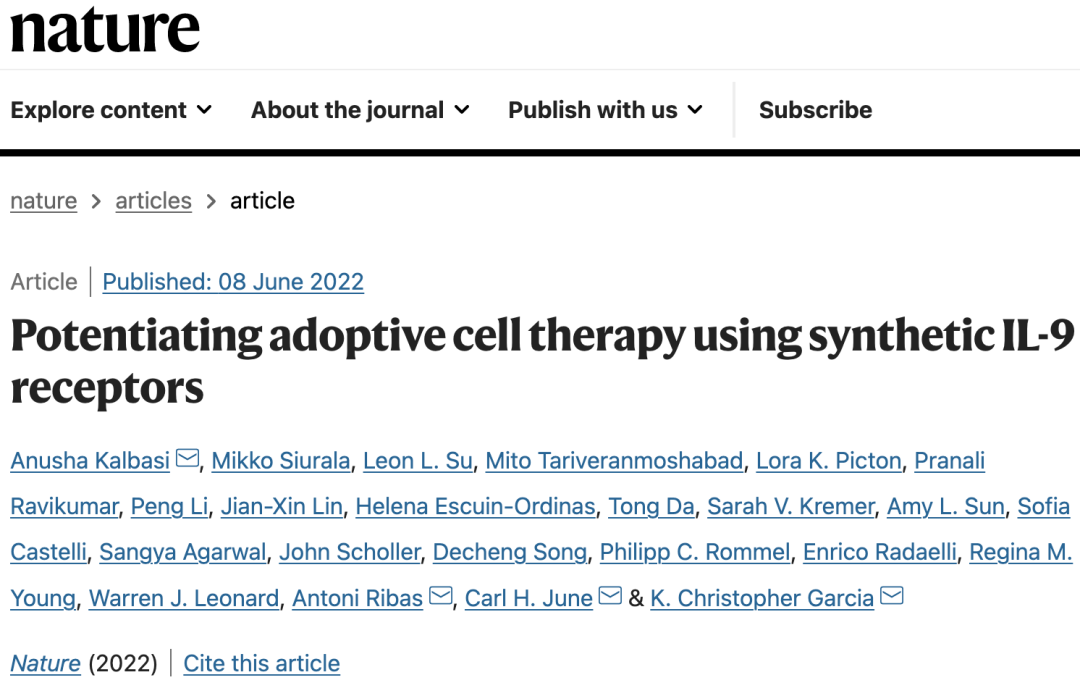预约演示
更新于:2025-05-07
OPL-0101
更新于:2025-05-07
概要
基本信息
药物类型 融合蛋白 |
别名 OMCP-mutIL2 + [2] |
作用方式 激动剂、拮抗剂 |
作用机制 IL-2R激动剂(白细胞介素-2受体复合体激动剂)、NKG2D拮抗剂(杀伤细胞凝集素样受体K1拮抗剂) |
在研适应症 |
非在研适应症- |
在研机构 |
非在研机构- |
权益机构- |
最高研发阶段临床前 |
首次获批日期- |
最高研发阶段(中国)- |
特殊审评- |
关联
100 项与 OPL-0101 相关的临床结果
登录后查看更多信息
100 项与 OPL-0101 相关的转化医学
登录后查看更多信息
100 项与 OPL-0101 相关的专利(医药)
登录后查看更多信息
6
项与 OPL-0101 相关的文献(医药)2023-03-16·Blood
Prevention of acute GVHD using an orthogonal IL-2/IL-2Rβ system to selectively expand regulatory T cells in vivo
Article
作者: Garcia, K. Christopher ; Su, Leon L. ; Simonetta, Federico ; Baker, Jeanette ; Ramos, Teresa L. ; Picton, Lora K. ; Wagner, John E. ; Thangavelu, Govindarajan ; Hirai, Toshihito ; Lohmeyer, Juliane K. ; Eide, Cindy ; Tolar, Jakub ; Saha, Asim ; Jin, Sujeong ; Koehn, Brent ; Lin, Po-Yu ; Panoskaltsis-Mortari, Angela ; Negrin, Robert S. ; Riddle, Megan ; Blazar, Bruce R. ; Bolivar-Wagers, Sara
2023-03-16·Blood
GVHD prophylaxis: use an ortho IL-2/IL-2Rβ Treg system!
Communications
作者: Wolf, Dietlinde
2022-05-23·JCI Insight
A reengineered common chain cytokine augments CD8+ T cell–dependent immunotherapy
Article
作者: Guo, Yizhan ; Westwick, John ; Lazear, Eric R ; Lau, Christine ; Krupnick, Alexander S ; Banerjee, Anirban ; Li, Dongge ; Schrum, Adam ; Mei, Zhongcheng ; Chen, Kelly ; Klauda, Jeffery B
2
项与 OPL-0101 相关的新闻(医药)2022-07-26
·生物谷
过继T细胞治疗,是目前全世界肿瘤治疗研究和临床试验的热点。
过继T细胞治疗,是目前全世界肿瘤治疗研究和临床试验的热点。
嵌合抗原受体T细胞(CAR-T)和T细胞抗原受体嵌合T细胞(TCR-T),是当前过继T细胞肿瘤免疫治疗中的“顶流”。尤其是目前已获得FDA批准的CAR-T疗法,正在改写部分血液系统肿瘤的治疗范式。
然而,过继T细胞治疗在实体瘤中仍收效甚微。主要原因在于,这些回输进患者体内的T细胞,需要随着外周血循环“跋山涉水”地到达肿瘤实质后,才能发挥杀伤作用。而在“杀敌”的路途中,机体的免疫抑制微环境使得回输的T细胞逐渐发生耗竭,无法持久地增殖和生存[1]。
为了提高过继T细胞治疗效果,患者往往需要预先接受放疗或者化疗性清髓。这种预处理方案,可能是通过平衡体内细胞因子产生,清除体内部分免疫抑制性细胞(如调节性T细胞和髓源性抑制细胞)等机制,提高了过继T细胞在体内的增殖能力和持久生存能力[2]。但是,高剂量的放化疗也给机体带来了严重的副作用,使得很多患者无法耐受清髓方案,而失去获益机会[3]。
近期,由斯坦福大学K. Christopher Garcia、宾夕法尼亚大学Carl H. June,以及加州大学洛杉矶分校Antoni Ribas和Anusha Kalbasi领衔的研究团队,在《自然》上发表了重要研究成果[4]。
他们首次设计出一种融合了正交IL-2受体(oIL-2R)和IL-9受体(IL-9R)嵌合受体,可在不需要预先放化疗清髓的情况下,活化过继T细胞,并赋予其干细胞样记忆T细胞和效应T细胞的双重表型,使之有效地发挥抗肿瘤功能。
更重要的是,这种新疗法已在黑色素瘤和胰腺癌的小鼠实体瘤模型中得到验证,为过继T细胞在实体瘤治疗中的研究和应用提供了新的策略。
论文首页截图
IL-2是一种效应T细胞增殖、生存和功能维持所需的细胞因子,是过继T细胞的重要治疗辅助。但IL-2的多效性以及IL-2R的广泛表达,也放大了抑制性免疫反应和全身的毒副作用,限制了其治疗用途。
Christopher Garcia的研究团队,2018年已经在Science发表了部分开创性的工作[5]。通过基因改造IL-2以及IL-2Rβ链的胞外域(ECD),他们设计了一个小鼠IL-2/IL-2Rβ正交对(orthogonal)。这种表达正交IL-2Rβ(o2R)的T细胞仅能由正交IL-2(oIL-2)激活,从而避免了活化其他免疫抑制细胞而引起机体的毒副反应。
在这个最新的研究中,研究人员希望利用oIL-2系统,研究γc细胞因子受体家族的其他成员[6]的治疗潜力。他们将o2R的胞内域(ICD)替换为γc细胞因子IL-4、IL-7、IL-9和IL-21受体的ICD,分别构建嵌合正交受体。
经过分析和筛选发现,其中o9R与已知的野生型IL-9受体的信号传导特征相似,能够导致STAT1,STAT3和STAT5磷酸化。
野生型IL-2Rβ,正交IL-2Rβ或γc家族嵌合正交受体结构和激活的磷酸化信号
根据已有研究报道,IL-9R主要表达于肥大细胞、记忆B细胞、先天淋巴细胞和造血祖细胞。在T细胞中也有以分泌IL-9为特征的Th9亚型。但是小鼠的T细胞不表达IL-9R,所以IL-9天然无法活化小鼠T细胞。而当研究人员给小鼠的T细胞人工转导上IL-9R后,用IL-9处理T细胞后也可以引起STAT1,STAT3,STAT5磷酸化。
同时,他们还发现,当用MSA-oIL-2激活o9R后,细胞能更高地表达CD62L、Sca-1和Fas(CD95),趋向于干细胞样记忆T细胞表型(Tscm),这是一种在过继细胞疗法中,能够持续存活并且发挥抗肿瘤活性的重要细胞类型[7]。
激活o9R后,细胞表型趋向于干细胞样记忆T细胞
鉴于o9R独特的信号转导和赋予细胞重要的表型特征,研究人员想利用这种新设计的过继T细胞来治疗实体瘤。
首先,他们利用表达gp100抗原的B16-F10小鼠黑色素瘤模型,用pmel小鼠T细胞作为改造来源(pmel T细胞的TCR本身能够识别gp100),结果发现在没有预先淋巴细胞清除性放疗的情况下,结合全身递送oIL-2,o9R pmel T细胞即能够发挥显著的抗肿瘤作用。
同时,o9R pmel T细胞不仅在肿瘤中浸润数量更多,并且其体外细胞溶解能力和IFNγ的产生也更高。研究人员利用转录组测序,鉴定和验证了决定o9R pmel T细胞浸润、效应功能和体内活性的相关基因。
他们发现,o9R除了能够诱导Tscm表型外,还观察到了与T细胞激活(Pdcd1、Icos、Entpd1、Lag3和Havcr2)和效应功能(Ifng、Gzma和Prf1)的相关基因富集。此外,Jun/Fos表达比增加,提示了对肿瘤诱导的衰竭有抵抗作用。与此同时,o9R信号下调了与T细胞功能障碍相关的基因(Nr4a1和Tox)。这说明,o9R或天然IL-9R信号通路或许诱导了异质性的混合亚群。
o9R pmel T细胞能够发挥显著的抗肿瘤作用
接下来,为了研究o9R信号转导在CAR-T中的作用,研究人员利用一种免疫治疗抵抗的模型——表达间皮素(mesothelin)的胰腺癌小鼠,并构建了CAR。同时,为了探讨o9R信号通路对肿瘤微环境中CAR-T细胞功能障碍的影响,他们设计了仅在瘤内用腺病毒载体递送oIL-2(Ad-oIL-2)。
结果显示,在没有预先淋巴细胞清除性化疗的情况下,Ad-oIL-2加CAR-o9R联合治疗,获得了更高比例的完全缓解(5/12)和更长的生存期。虽然与pmel模型相比,肿瘤中CAR-o9R比CAR-o2R T细胞浸润数量更少,但是CAR-o9R T细胞的转录组变化仍旧与o9R pmel T细胞相似。
局部递送Ad-oIL-2 与CAR-o9R 联合治疗,胰腺癌小鼠完全缓解率更高和细胞杀伤作用更强
那么,这种新方法是否有潜力应用于临床呢?作者设计了人源的正交IL-2Rβ(ho2R)和嵌合IL-2Rβ-IL-9R(ho9R),并以此为基础分别构建了可识别肿瘤抗原NY-ESO-1和mesothelin的TCR T细胞和CAR-T细胞。结果显示,与小鼠相似,ho9R激活了一致的磷酸化信号、干细胞样的功能表型以及更强的多功能性效应分子表达和杀伤能力。
总的来说,这个研究设计了一种新的嵌合受体o9R来改造T细胞,使之获得了一种独特的干细胞记忆T细胞和效应T细胞的双重身份,能够在体内长期存活增殖并杀伤肿瘤。
无论是将细胞因子oIL-2对荷瘤小鼠进行全身给药还是肿瘤局部给药,这种改造的T细胞,都能够在免除放化疗清髓的情况下,在体内发挥显著的抗肿瘤效果。
这个新方法,对于过继T细胞在实体瘤治疗来说,无疑具有重要意义。同时,这个研究构建并在体外验证的人源o9R T细胞,也为后续的临床转化提供了有吸引力的数据。
参考文献
[1] Schietinger A, Philip M, Krisnawan VE, et al. Tumor-Specific T Cell Dysfunction Is a Dynamic Antigen-Driven Differentiation Program Initiated Early during Tumorigenesis. Immunity. 2016;45(2):389-401. doi:10.1016/j.immuni.2016.07.011
[2] Rosenberg SA, Restifo NP. Adoptive cell transfer as personalized immunotherapy for human cancer. Science. 2015;348(6230):62-68. doi:10.1126/science.aaa4967
[3] Dudley ME, Yang JC, Sherry R, et al. Adoptive cell therapy for patients with metastatic melanoma: evaluation of intensive myeloablative chemoradiation preparative regimens. J Clin Oncol. 2008;26(32):5233-5239. doi:10.1200/JCO.2008.16.5449
[4] Kalbasi A, Siurala M, Su LL, et al. Potentiating adoptive cell therapy using synthetic IL-9 receptors [published online ahead of print, 2022 Jun 8]. Nature. 2022;10.1038/s41586-022-04801-2. doi:10.1038/s41586-022-04801-2
[5] Sockolosky JT, Trotta E, Parisi G, et al. Selective targeting of engineered T cells using orthogonal IL-2 cytokine-receptor complexes. Science. 2018;359(6379):1037-1042. doi:10.1126/science.aar3246
[6] Leonard WJ, Lin JX, O'Shea JJ. The γc Family of Cytokines: Basic Biology to Therapeutic Ramifications. Immunity. 2019;50(4):832-850. doi:10.1016/j.immuni.2019.03.028
[7] Krishna S, Lowery FJ, Copeland AR, et al. Stem-like CD8 T cells mediate response of adoptive cell immunotherapy against human cancer. Science. 2020;370(6522):1328-1334. doi:10.1126/science.abb9847

免疫疗法细胞疗法放射疗法
2021-06-10
Valo Health, a drug discovery company that launched less than a year ago, is joining the public markets through a merger deal that values the firm at about $2.8 billion.
The Boston-based company on Wednesday announced an agreement to merge with Khosla Ventures Acquisition, a special purpose acquisition company (SPAC). When the deal closes, the combined company will have a cash balance of about $750 million, before transaction expenses.
Valo aspires to become the first “digitally native” pharmaceutical company, according to an investor presentation. The Valo name likely isn’t familiar to many people but its founding investor, Flagship Pioneering, might be. Flagship is a venture capital firm that has a track record of forming companies that have platform technologies addressing big scientific problems. Perhaps the best-known company to emerge from Flagship is messenger RNA biotech Moderna.
Flagship launched Valo last September, but the company actually began taking shape in 2019 with the acquisition of drug discovery startup Numerate. That San Bruno, California-based company had created a platform with more than 30,000 models, 70 trillion molecules, and more than 25 drug programs. The following year, Valo expanded further with the purchase of assets from Forma Therapeutics, including libraries of compounds and experimental drugs in development.
Samir Kaul, founding partner and managing director at Khosla Ventures, met Valo founder and CEO David Berry at Flagship, where Berry has been a general partner since 2005. In an investor presentation, Berry described the legacy model of drug discovery and development as dated, slow, and expensive. The Valo drug discovery technology, Opal, is intended to achieve better success by taking an approach that puts humans at the center of drug discovery and development.
“We see a lot of efforts that are applying AI cells in the legacy model,” Berry said. “That approach suffers from the same translation issue that it always has—cells are cells, cells are not people, diseases are complicated. We are building a system with the depth to reflect actual diseases in people rather than in an artificial representation.”
Opal does not just design and synthesize molecules. Berry said that the technology runs simulations that a molecule is optimized for its activity against disease, is better processed by the body, and offers low toxicity. The company claims it has built more than 30,000 predictive models, made more than 2 billion predictions.
Patient data form the foundation of Opal; those data are interrogated by artificial intelligence. Berry said Opal yields insights such as identifying key clinical response patterns to a drug and finding patient subpopulations that could be treated by the therapy. Each experiment Opal runs is reentered into the platform; machine learning techniques applied to those experiments makes the system better, smarter, more efficient, Berry said.
While Valo has an internal pipeline of drugs, the company also plans to pursue partnerships with companies interested in leveraging Opal for their own insights. In the future, Berry said he envisions the launch of Opal-enabled software businesses that put the company’s business model “as the default choice for all drug developers and beyond.”
In the nearer term, Valo will focus on the drugs currently in its pipeline. Valo has 17 programs for cardiovascular/metabolic/renal disorders, cancer, and neurodegenerative diseases. The two most advanced programs are both Phase 2 ready: OPL-0301 is in development for acute kidney injury and OPL-0401 is a potential treatment for diabetic complications such as diabetic retinopathy.
According to the investor presentation, Valo plans to start a Phase 2 clinical trial for OPL-0301 in the fourth quarter of this year. A Phase 2 test of OPL-0401 is planned for next year. The company also plans to bring its most advanced cancer program, an immune-oncology candidate called OPL-0101, into the preclinical research that will support an application to begin human testing.
When the merger closes, the combined company’s cash balance will come from about $250 million in Valo’s coffers and about $333 million from Khosla. The new Valo will also raise $168.5 million in a private financing that includes commitments from earlier Valo investors as well as new investors to the company.
Disclosed new investors include Khosla Ventures, NG MGG Strategic, Caz Investments. Returning investors include Koch Disruptive Technologies, Flagship Pioneering, Public Sector Pension Investment Board, Invus, State of Michigan Retirement Systems, HBM Healthcare Investments and Longevity Vision Fund.
The capital raised from the merger will be used to advance development of Valo’s preclinical and clinical assets, develop its software platform, and support the company’s growth plans.
Image by Flickr user luckey_sun via a Creative Commons license
并购信使RNA
100 项与 OPL-0101 相关的药物交易
登录后查看更多信息
研发状态
10 条进展最快的记录, 后查看更多信息
登录
| 适应症 | 最高研发状态 | 国家/地区 | 公司 | 日期 |
|---|---|---|---|---|
| 局部晚期黑色素瘤 | 临床前 | 美国 | - |
登录后查看更多信息
临床结果
临床结果
适应症
分期
评价
查看全部结果
| 研究 | 分期 | 人群特征 | 评价人数 | 分组 | 结果 | 评价 | 发布日期 |
|---|
No Data | |||||||
登录后查看更多信息
转化医学
使用我们的转化医学数据加速您的研究。
登录
或

药物交易
使用我们的药物交易数据加速您的研究。
登录
或

核心专利
使用我们的核心专利数据促进您的研究。
登录
或

临床分析
紧跟全球注册中心的最新临床试验。
登录
或

批准
利用最新的监管批准信息加速您的研究。
登录
或

生物类似药
生物类似药在不同国家/地区的竞争态势。请注意临床1/2期并入临床2期,临床2/3期并入临床3期
登录
或

特殊审评
只需点击几下即可了解关键药物信息。
登录
或

生物医药百科问答
全新生物医药AI Agent 覆盖科研全链路,让突破性发现快人一步
立即开始免费试用!
智慧芽新药情报库是智慧芽专为生命科学人士构建的基于AI的创新药情报平台,助您全方位提升您的研发与决策效率。
立即开始数据试用!
智慧芽新药库数据也通过智慧芽数据服务平台,以API或者数据包形式对外开放,助您更加充分利用智慧芽新药情报信息。
生物序列数据库
生物药研发创新
免费使用
化学结构数据库
小分子化药研发创新
免费使用

